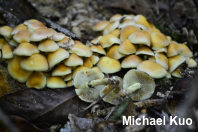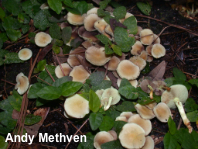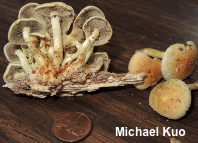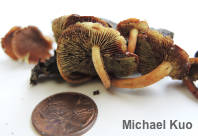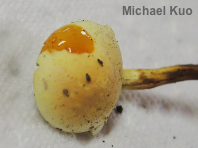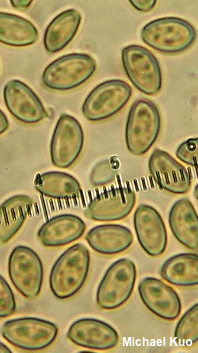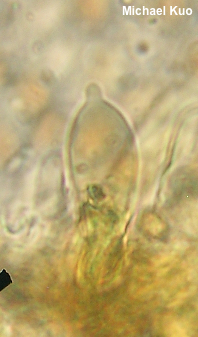| Major Groups > Gilled Mushrooms > Dark-Spored > Hypholoma > Hypholoma subviride |

|
Hypholoma subviride [ Basidiomycota > Agaricales > Strophariaceae > Hypholoma . . . ] by Michael Kuo Hypholoma subviride is basically a smaller version of the better-known Hypholoma fasciculare, with a more southerly distribution. Like Hypholoma fasciculare it grows in clusters on deadwood and features a yellow-when-fresh cap, greenish yellow gills, and very bitter taste. However, the cap measures 1–3 cm across (as compared to 2–5 cm for Hypholoma fasciculare), and Hypholoma subviride is limited to tropical and subtropical locations, or to potential regions of glacial refugia like the Ozark and southern Appalachian Mountains. Mycology has gone back and forth over whether Hypholoma subviride is a legitimately separated species, but tropical treatments have consistently argued for the separation—and a very thorough contemporary study (Sato and collaborators 2020) provides good support for separating the species. Thanks to Andy Methven for facilitating study of Hypholoma subviride. Description: Ecology: Saprobic; growing in clusters on decaying logs and stumps of conifers and hardwoods; summer through winter; originally described from Cuba and found throughout the Caribbean; in North America apparently restricted to the southeastern United States, the southern Appalachians, the Ozarks, and Mexico; also reported from Central America, South America, New Zealand, and Africa. The illustrated and described collections are from Georgia, Missouri, and Ohio. Cap: 1.5–3 cm across; convex, becoming broadly convex or nearly flat; bald; moist when fresh but soon dry; orangish yellow centrally and paler yellow marginally—or greenish yellow overall, becoming orangish brown to brown with age; the margin not lined, often featuring small, wispy, whitish to grayish partial veil fragments. Gills: Broadly attached to the stem; close; short-gills frequent; pale sulphur yellow, becoming greenish yellow, and eventually grayish brown to blackish. Stem: 2–4 cm long; 2–4 mm thick; equal; bald or slightly fibrillose in places; dry; pale yellow, becoming brownish toward the base; often with a fragile yellowish ring or ring zone that becomes blackish as spores mature. Flesh: Yellow; not changing when sliced. Odor and Taste: Odor not distinctive; taste bitter. Chemical Reactions: KOH red on cap surface. Spore Print: Purplish gray to blackish. Microscopic Features: Spores: 5–9 x 3–4.5 µm; ellipsoid, with a small (0.5 µm) pore; smooth; walls 0.5–1 µm thick; dull golden in KOH. Basidia 20–25 x 4–5 µm; cylindric; 4-sterigmate. Pleurocystidia and cheilocystidia as chrysocystidia; 25–40 x 7.5–10 µm; clavate to mucronate-lageniform; smooth; thin-walled; hyaline with golden globular contents in KOH. Pileipellis an ixocutis; elements 2.5–5 µm wide, smooth, hyaline to yellowish in KOH, with clamp connections. Subpellis cellular; elements 10–20 µm wide, subglobose, smooth, reddish in KOH. REFERENCES: (Berkeley & Curtis, 1869) Dennis, 1961. (Smith, 1951; Weber & Smith, 1985; Cortez & Coelho, 2004; Sulzbacher et al., 2007; Desjardin & Perry, 2016; Elliott & Stephenson, 2018; Vesterholt & Rald, 2018; Sato et al., 2020.) Herb. Kuo 07151608, 09301705, 10082001 (portion of ASM 12483). This website contains no information about the edibility or toxicity of mushrooms. |
© MushroomExpert.Com |
|
Cite this page as: Kuo, M. (2020, October). Hypholoma subviride. Retrieved from the MushroomExpert.Com Web site: http://www.mushroomexpert.com/hypholoma_subviride.html |
